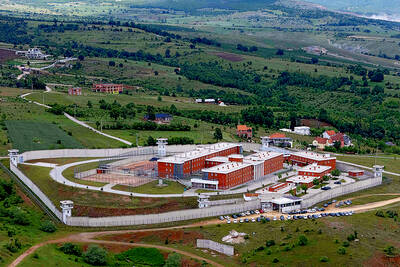While recent tensions in the South China Sea have highlighted the Philippines’ maritime vulnerabilities, the more insidious risk of state-sponsored cyberattacks — and a lack of resources to handle them — might be the country’s bigger challenge.
A report released in November last year blamed a Chinese group known as Stately Taurus for an attack that had compromised a Philippine government agency for five days earlier that year, coinciding with clashes between the two countries’ ships in the South China Sea.
Stately Taurus’ operations “align with geopolitical topics of interest to the Chinese government,” said Palo Alto Networks, the US cybersecurity firm that produced the report.

Photo: Reuters
Although Philippine officials say it is difficult to pin any cyberattack on one specific country, online security breaches in the Southeast Asian nation are widespread.
More than 60,000 user accounts were compromised in the third quarter of last year, cybersecurity company Surfshark said, putting the Philippines among the world’s 30 most-attacked countries.
In September last year, state insurer Philippine Health Insurance Corp suffered a huge data leak. Hackers defaced the Web site of the Philippine House of Representatives weeks later.
“Cyberattacks are a bigger threat than the firing of water cannons,” said Sherwin Ona, a cyberdefense consultant to the Philippine National Security Council and an associate professor at De La Salle University in Manila.
The government’s cyberresponse team has 35 members. The group is so understaffed that it is sometimes forced to work with anonymous “black hat” hackers, who might have previously attacked government Web sites, but are willing to offer tips on looming threats, said Jeffrey Ian Dy, undersecretary at the Philippine Department of Information and Communications Technology.
“Do we even have the capability, with just 30 people looking at each and every weakness? We do not,” Dy said, adding that the team would ideally number about 200. “We do our best to defend the republic.”
A shortage of funds is the primary obstacle, he said.
The Philippines lacks a competitive pay scale to recruit and retain cybertalent within government agencies, research backed by the US Agency for International Development showed.
Ona said that the experience of Taiwan, which has been subject to massive cyberattacks from China, is particularly instructive for the Philippines.
“China is using Russia’s playbook and uses it against its adversaries,” he said.
Government agencies are not the only ones taking increasing notice of the threat. Armed Forces of the Philippines Chief of Staff General Romeo Brawner Jr in October last year announced plans to recruit more “cyberwarriors” to combat what he described as near-daily threats, including from unidentified foreign forces.
“Worldwide, cyber is really becoming a very important domain in warfare,” Brawner said at the time. “This new breed of warriors don’t necessarily have to be muscled. What we need are individuals who are intelligent and very skillful in [the] cyber domain.”
In the past few months, governments around the world have warned of China’s potential digital threat.
In its latest Annual Threat Assessment, the US Office of the Director of National Intelligence said that “China probably currently represents the broadest, most active and persistent cyberespionage threat to US government and private-sector networks.”

By 2027, Denmark would relocate its foreign convicts to a prison in Kosovo under a 200-million-euro (US$228.6 million) agreement that has raised concerns among non-governmental organizations (NGOs) and residents, but which could serve as a model for the rest of the EU. The agreement, reached in 2022 and ratified by Kosovar lawmakers last year, provides for the reception of up to 300 foreign prisoners sentenced in Denmark. They must not have been convicted of terrorism or war crimes, or have a mental condition or terminal disease. Once their sentence is completed in Kosovan, they would be deported to their home country. In

Brazil, the world’s largest Roman Catholic country, saw its Catholic population decline further in 2022, while evangelical Christians and those with no religion continued to rise, census data released on Friday by the Brazilian Institute of Geography and Statistics (IBGE) showed. The census indicated that Brazil had 100.2 million Roman Catholics in 2022, accounting for 56.7 percent of the population, down from 65.1 percent or 105.4 million recorded in the 2010 census. Meanwhile, the share of evangelical Christians rose to 26.9 percent last year, up from 21.6 percent in 2010, adding 12 million followers to reach 47.4 million — the highest figure

LOST CONTACT: The mission carried payloads from Japan, the US and Taiwan’s National Central University, including a deep space radiation probe, ispace said Japanese company ispace said its uncrewed moon lander likely crashed onto the moon’s surface during its lunar touchdown attempt yesterday, marking another failure two years after its unsuccessful inaugural mission. Tokyo-based ispace had hoped to join US firms Intuitive Machines and Firefly Aerospace as companies that have accomplished commercial landings amid a global race for the moon, which includes state-run missions from China and India. A successful mission would have made ispace the first company outside the US to achieve a moon landing. Resilience, ispace’s second lunar lander, could not decelerate fast enough as it approached the moon, and the company has

‘THE RED LINE’: Colombian President Gustavo Petro promised a thorough probe into the attack on the senator, who had announced his presidential bid in March Colombian Senator Miguel Uribe Turbay, a possible candidate in the country’s presidential election next year, was shot and wounded at a campaign rally in Bogota on Saturday, authorities said. His conservative Democratic Center party released a statement calling it “an unacceptable act of violence.” The attack took place in a park in the Fontibon neighborhood when armed assailants shot him from behind, said the right-wing Democratic Center, which was the party of former Colombian president Alvaro Uribe. The men are not related. Images circulating on social media showed Uribe Turbay, 39, covered in blood being held by several people. The Santa Fe Foundation